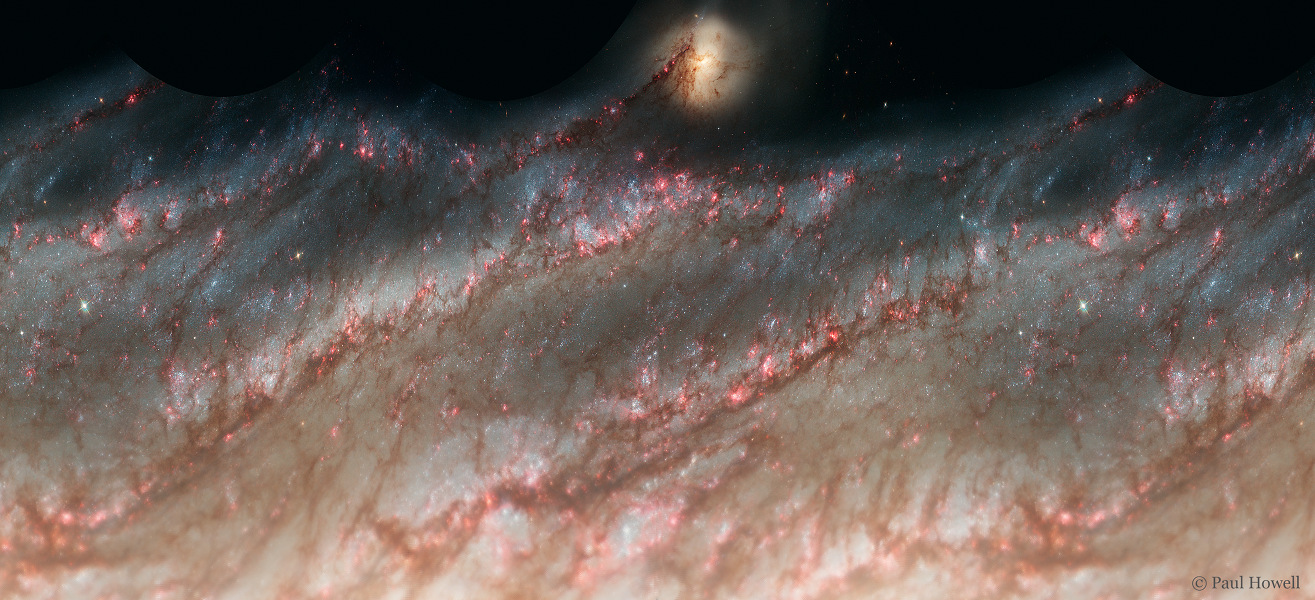釋放 M 51
Unwinding M51

來源:Hubble Heritage Project|發表日期:2024-04-06
在這張 2005 年哈勃太空望遠鏡拍攝的 M 51 宏偉畫像的數碼影像中,一個直徑達 6 萬光年的宏偉設計螺旋星系的旋臂徐徐展開。事實上,M 51 是最原始的螺旋星雲之一,它蜿蜒的旋臂由一條數學曲線描述,這條曲線被稱為對數螺旋,螺旋的分離度隨著與中心距離的增加而呈幾何級數增長。應用對數來移動哈勃影像中相對於 M 51 中心的畫素座標,可以將星系的旋臂對映成對角直線。變換後的影像清晰地顯示出旋臂本身是由恆星形成的,兩邊是粉紅色的恆星形成區和年輕的藍色星團。不過,伴星系 NGC 5195 (上圖)似乎改變了它前面旋臂的軌跡,而它本身則相對不受 M 51 旋臂的影響。對數螺旋也被稱為 "奇蹟螺旋"(spira mirabilis),在自然界的各種尺度上都能發現。例如,對數螺旋也可以描述颶風、亞原子粒子在氣泡室中的軌跡,當然還有菜花。 美國國家航空航天局報道: 2024 年日全食 4 月 8 日
原文:The arms of a grand design spiral galaxy 60,000 light-years across are unwound in this digital transformation of the magnificent 2005 Hubble Space Telescope portrait of M51. In fact, M51 is one of the original spiral nebulae, its winding arms described by a mathematical curve known as a logarithmic spiral, a spiral whose separation grows in a geometric way with increasing distance from the center. Applying logarithms to shift the pixel coordinates in the Hubble image relative to the center of M51 maps the galaxy's spiral arms into diagonal straight lines. The transformed image dramatically shows the arms themselves are traced by star formation, lined with pinkish starforming regions and young blue star clusters. Companion galaxy NGC 5195 (top) seems to alter the track of the arm in front of it though, and itself remains relatively unaffected by this unwinding of M51. Also known as the spira mirabilis, logarthimic spirals can be found in nature on all scales. For example, logarithmic spirals can also describe hurricanes, the tracks of subatomic particles in a bubble chamber and, of course, cauliflower. NASA Coverage: Total Solar Eclipse of 2024 April 8
※ 本文由萌芽機器人自動轉貼自每日一天文圖(Astronomy Picture of the Day,APOD),原文為英文,正體中文是透過 DeepL 翻譯及 OpenCC 進行自動處理,內容僅供參考,若有任何錯誤之處還請見諒!
關於每日一天文圖:每日一天文圖網站是美國國家航空暨太空總署與密西根理工大學提供的服務,網站每天提供一張影像或圖片,並由天文學家撰寫扼要說明其特別之處。